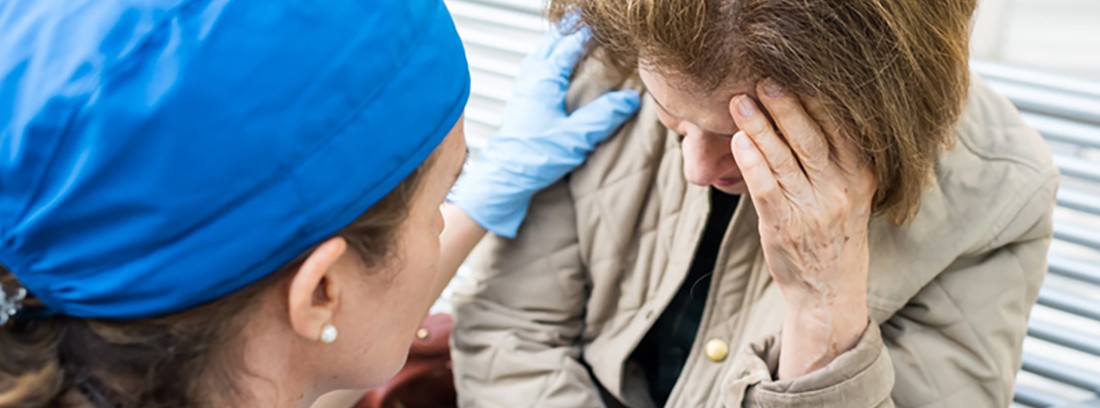Vertigo

There are a number of situations that are sometimes mistakenly defined as vertigo, such as dizziness, fainting, and instability. Dizziness is an alteration of orientation in space. It appears frequently in stressful situations or in closed places. Physical examination is normal.
Fainting (presyncope or fainting) is defined as the feeling of immediate loss of consciousness. They are sudden episodes with rapid recovery. It requires the study of its origin, which can be cardiac, neurological and vasovagal among the most frequent causes.
How it is produced
Vertigo is caused by an alteration of the vestibular system. This alteration can be of peripheral cause (peripheral vertigo) or central (central vertigo). Vertigo of peripheral origin is the most common cause of vertigo.
For the maintenance of balance, the body has three systems that are mainly interrelated in the cerebellum, which are: the vestibular system, the proprioceptive system and the organ of vision.
- The proprioceptive system is the ability to know the position of each of the parts of the body
- The vestibular system is located inside the ear, where a liquid is located that moves with the different movements of the body, informing the nervous system of these. Finally
- The organ of vision is the reference that each individual has of their own environment and of themselves. For equilibrium to exist, at least two of these three systems need to work.
In vertigo, the vestibular system is affected, producing a sensation of movement when in fact it does not exist. The organ of vision produces secondarily characteristic movements to try to maintain a fixed point (nystagmus) and the proprioceptive system tries to compensate, giving rise to an imbalance. This alteration can be of peripheral cause (peripheral vertigo) or central (central vertigo).
The most common causes of peripheral vertigo are Menière's disease, infection (labyrinthitis and vestibular neuronitis), head trauma, drugs (aspirin, diuretics, lithium), toxins (alcohol, arsenic), tumors (meningioma, cholesteatoma, and nerve VIII nerveoma). ) and sudden pressure changes.
Causes of central vertigo include stroke, multiple sclerosis, basilar artery migraine (migraine preceded by neurological symptoms), temporal lobe epilepsy, and posterior fossa tumors.
Symptoms
Vertigo presents a very characteristic symptomatology in the form of a rotating sensation of objects that the patient defines as "going on a boat" or "going like a drunk", which can be of variable intensity, from mild to an incapacitating situation during the episode. It is usually accompanied by vegetative symptoms such as nausea, vomiting, tachycardia and arterial hypotension.
In cases of peripheral vertigo (up to 75% of vertigos), a horizontal rotating movement of the eyes (nystagmus) appears. They are episodes of abrupt onset, brief and with abundant vegetative symptoms, predominantly vomiting. Crises are often triggered by movement.
Vertigos of central origin present without relation to posture, are slower onset and of longer duration, and vomiting is less present. Nystagmus also appears, but this is usually vertical.
It is important to differentiate one type of vertigo from the other, due to the different causes that produce them. Thus, while in peripheral vertigo, half of them will be benign positional vertigo that will disappear without sequelae with correct action, vertigos of central origin (although much less frequent) hide more serious brain pathology.
Diagnosis
It is mainly based on a good history and a complete neurological examination. It is advisable to initially differentiate whether the clinical picture is dizziness or vertigo, taking into account that up to 50% of dizziness is vertigo.
It is important to ask about the characteristics of dizziness: vertigo will be explained as a rotating sensation of objects, while dizziness will be explained in a less specific way, without clear symptoms (feeling of falling, emptiness in the head, imbalance). It is also necessary to know its duration, its triggering factors, accompanying symptoms as well as the patient's history, especially the existence of cardiovascular risk factors.
The physical examination will include a neurological examination in search of nystagmus, tests aimed at assessing the patient's balance such as the Romberg test (with the patient standing, they are made to close their eyes and see if the patient falls or not and towards what side. In case of vertigo, the patient will fall towards the damaged vestibular side). Finger-nose coordination is used to assess the integrity of the cerebellum, and the Hallpicke test is useful for the diagnosis of benign positional vertigo. It consists of reproducing vertigo and nystagmus by passing the patient from a sitting position to lying down with the head turned towards the affected side.
On some occasions, the use of certain complementary examinations such as the electrocardiogram, audiometry, brain CT and / or evoked potentials or the electroencephalogram may be indicated. blood tests are usually normal.
Treatment
It is important to recommend rest during the acute episode of vertigo together with antivertiginous and / or antiemetic drugs in the case of nausea and vomiting. These can be administered rectally or intramuscularly.
The most widely used antivertiginous drugs are dimenhydrate, hydroxyzine, sulpiride, and thiethylperazine during the attack and subsequently for 3 to 5 more days at home.
In cases of positional vertigo, it is useful to perform vestibular rehabilitation exercises 3 days after the acute episode. These are performed while the patient is in a sitting position with his eyes closed, falling to both sides alternately and quickly. Repeating these exercises for 4 or 5 days, and several times a day progressively improves vertigo.
However, in addition to the treatment of the acute phase of vertigo, it is necessary to investigate the cause that has produced it in order to offer the appropriate treatment in each case.
(Updated at Apr 15 / 2024)